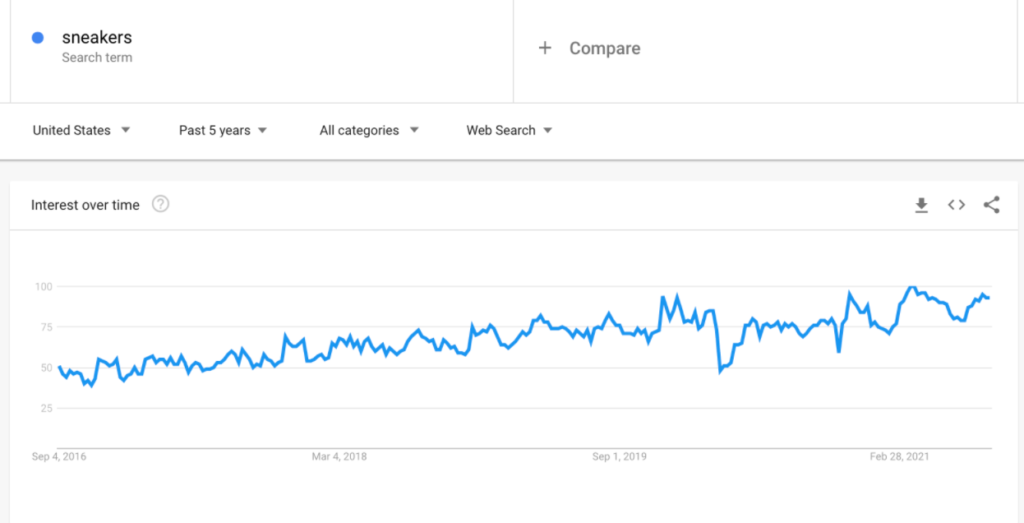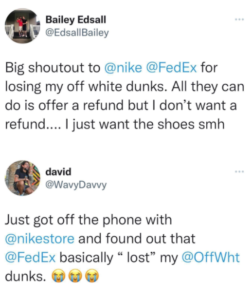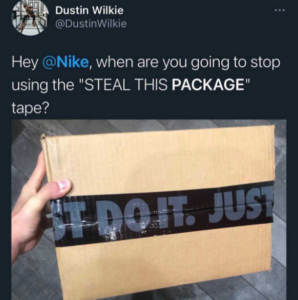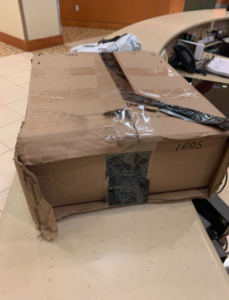Even if you’re not a sneakerhead, you may have noticed the increased interest in sneakers within the last several years – already growing in popularity pre-Covid thanks to the popularity of Kanye West’s Yeezy designs, among others, they’ve entrenched themselves even more as key components of during- and post-pandemic wardrobes and even as lucrative investments.
It’s safe to say that sneakers are having a very mainstream moment:

Some, of course, are more rare and coveted than others. This has led to the emergence of sneaker resellers, price inflation, and the use of technology like “sneaker bots” to gain an unfair advantage in purchasing sneakers when they’re released.
All of the major sneaker brands have made major attempts to stop these bots on the technical side so more real people have a fair chance at making a purchase. Recently, Nike pursued a new strategy that was intended to reward its most loyal (and human) users with a program called “Exclusive Access” – giving a guaranteed invite to purchase a pair of coveted sneakers to those people who are interacting with the Nike SNKRS app the most. Though Nike might be best known for Jordans, the brand also has a partnership with designer Virgil Abloh to bring his unique designs and colorways to many popular Nike shoes. A few weeks ago, the most recent Virgil Abloh designs were doled out with new Exclusive Access invites.
As a customer experience strategy, this seemed like a good one. It demonstrated a good-faith effort to get rare shoes into the hands of those who appreciated them, rather than resellers. It created excitement and made those who were selected feel recognized and appreciated – with little downside, as those who were not selected are so used to missing out on the opportunity to purchase shoes (in sneaker parlance, “taking the L” or loss) the disappointment was, for most, minimal.
Sounds great, right? Unfortunately, there were quite a few cases where these sneakers never made it into the right hands. Perhaps it was the publicity around the release or the value of some of the shoes (or both), but social media quickly blew up with reports of FedEx delivery services “losing” their shoes in transit, empty boxes arriving, or the labels or shoes themselves having been switched. For example:

At first you might think “This isn’t Nike’s fault,” but sneakerheads have been warning Nike for a long time that using “Just Do It” tape to seal boxes is not a good idea, as it’s a magnet for thieves at every point in the delivery process. The tape makes it obvious from quite a distance that the box contains valuable Nike merchandise rather than a much less resaleable set of spatulas or box of dog treats.

This is direct feedback that has been provided to Nike for years, though in the past theft incidents were more sporadic – as an example, here’s a photo from the delivery of a pair of Nike x Fear Of God sneakers I ordered in May 2020 that arrived opened and with some of the accessories missing (perhaps for someone to pair with counterfeits they were reselling). Presumably, the “Just Do It” tape alerted someone along the line to take a closer look at the contents – and it wasn’t my concierge as I was anxiously awaiting these so they were in my hands right after drop-off!

At least I got my actual shoes because when this happens, the company can’t do anything but offer you a refund; with limited edition shoes, there aren’t any in reserve to replace missing or damaged items. It’s a very negative experience for the customer.
I provided this photo to their customer service team as well as posting it on social media (no response) as part of a thread where others had similar problems. My shoes were delivered via UPS, so the problem isn’t necessarily carrier-specific. It is, however, customer-experience-specific, and likely could have been averted or ameliorated with more anonymous, tamper-safe packaging – simple changes to make if you listen to your customers who are alerting you to problems that arise, rather than having these become much larger problems later. This wasn’t new, and most sneakerheads had either had a problem with it in the past or knew someone who had. It just hadn’t reached epidemic levels until now, and Nike could’ve stopped it well before this. There are assuredly expensive, technical fixes for this problem that they might be reluctant to take on, like individual RFIDs for each pair of shoes that could be registered with resellers like StockX to block resale of shoes reported missing, assuming most of the thefts were for resale. But customers themselves had pointed out a very inexpensive likely fix.
Social monitoring provides immediate feedback that can alert a brand to this type of issue – for example, taking a closer look at common tweets with negative sentiment. Additionally, the regular use of a post-purchase survey would have made it easy to identify not just issues like this but the local or regional hotspots where they happen.
We haven’t heard if Nike will be making the packaging changes that many of us have long requested, or taking other actions to identify theft hotspots in their delivery chain, but that doesn’t mean other brands can’t learn from this. Overall, the lesson seems to be that surprise-and-delight strategies – like unexpected Exclusive Access to a rare sneaker for your more devoted brand followers – are great, and should benefit your brand with even more loyalty, but require followthrough to ensure that there are no pitfalls any step of the way, so it doesn’t become a customer service nightmare.
If you’d like to learn more about sentiment analysis, social monitoring and how to implement a survey program for customer feedback to ensure your customer experience is flawless all the way through post-purchase, contact us to learn more.